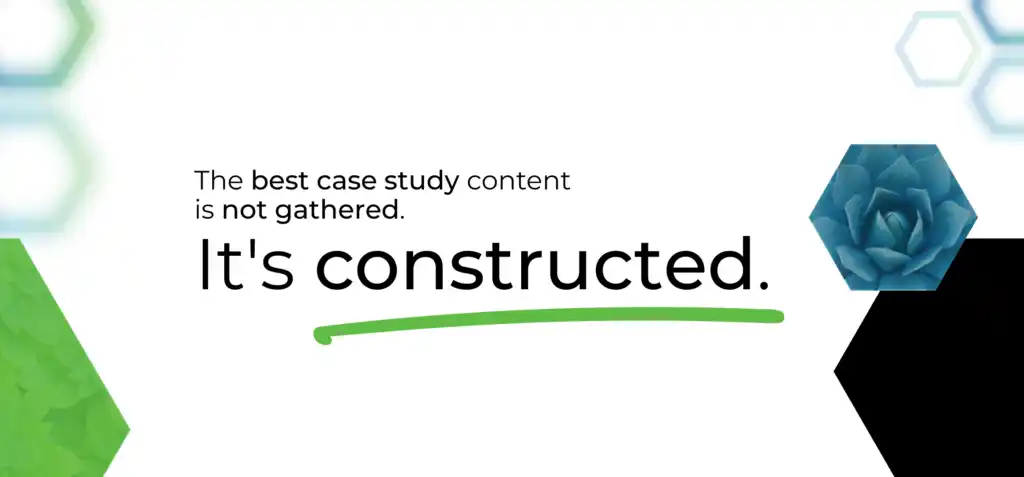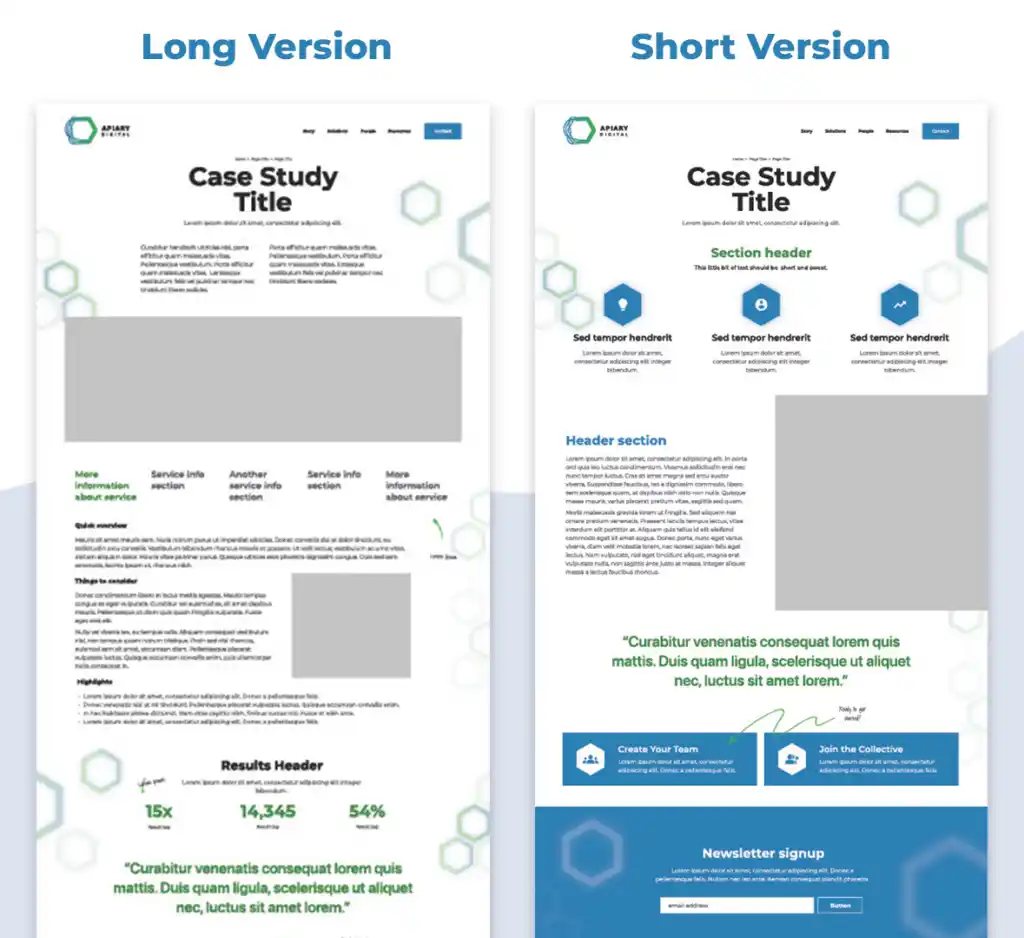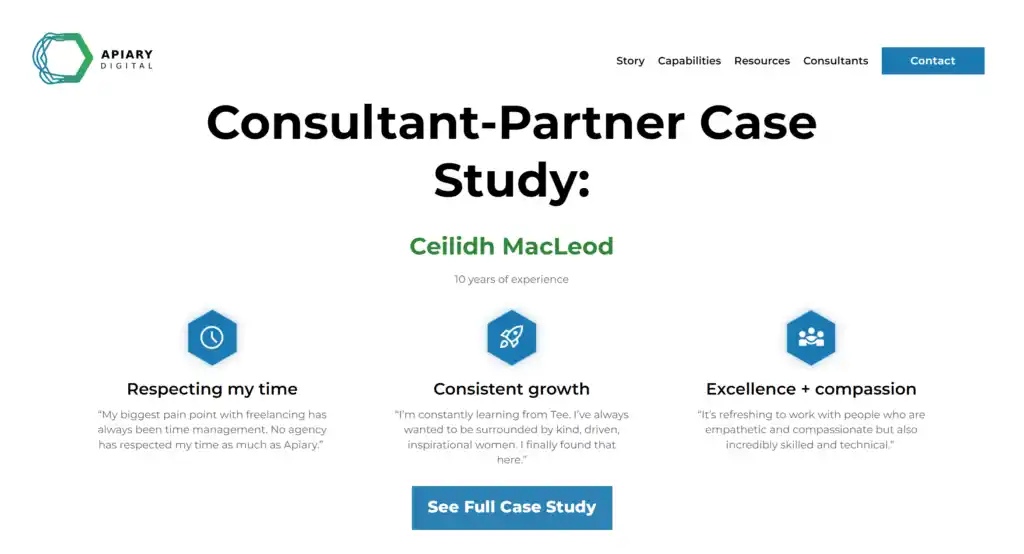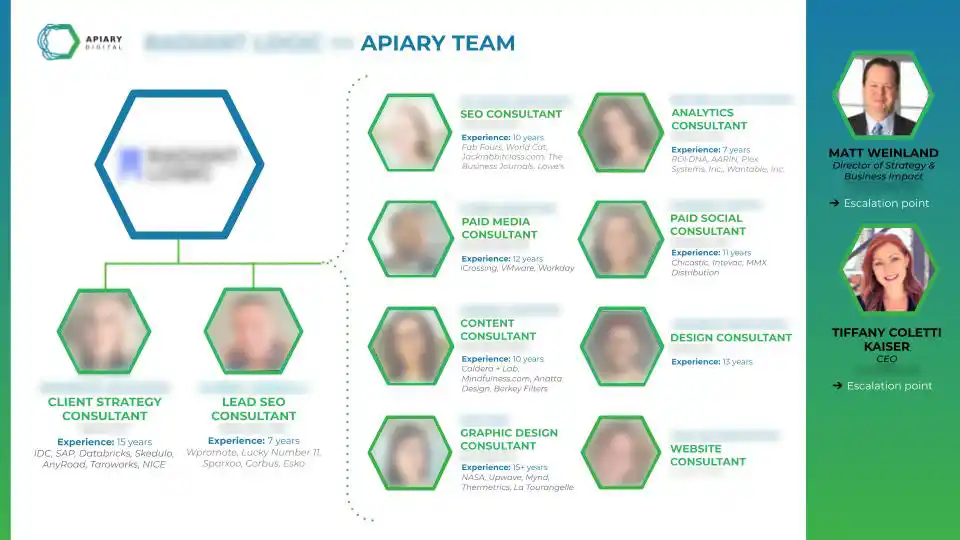
Even if you’re highly confident in your decision-making skills, most of us are wired to be influenced by social proof.
Social proof is a psychological principle first coined by Dr. Robert Cialdini. After analyzing several social behavior studies, Cialdini observed that when people are uncertain (like, for example, when deciding whether to make a purchase) they seek behavioral guidance from others – people they admire and/or have something in common with.
As marketers looking to leverage the persuasive potential of social proof at the right juncture in the customer journey, there are several types we can choose from, including:
- Client logos
- Testimonials – written or video
- Testimonials – social media UGC
- Customer/subscriber/social following metrics
- Case studies
Especially for service-based and B2B brands, case studies are typically the most ideal form of social proof.
Case studies are one of the most common types of social proof we recommend, and use to showcase our own client-partners and consultant-partners, for a few reasons:
- If you have a long sales cycle, one way to keep leads engaged and moving down the funnel is by providing a variety of content types that educate and address their objections. Case studies are great at this.
- If your business model or product innovates in any way, a smartly-constructed case study helps to ensure that your audience is clear on exactly what you’re offering and what outcomes they can reasonably expect.
- If you run a service-based business, or sell a product that includes a service component, leads aren’t just interested in the results you deliver, but HOW you deliver them. They want to know what it will be like to work with you and your team. The best case studies highlight outcomes and the quality of the process that generated them.
- All other marketing content is generated by your opinion of yourself, and a prospect knows that. But a case study is (supposed to be) a fluff-free account of someone else’s experience with you and the results you delivered. Most people find this kind of content inherently more trustworthy.
- While the other types of social proof mentioned above are typically standalone elements, a case study can easily be structured to include all of them. More bang for your buck.

But there are many possible approaches to creating case studies, so what are the essential components and what’s optional?
We’ve compiled some of our best learnings from creating case studies that convert. In this deep dive, we’re going to cover:
- The ideal length for a case study
- The 3 most important components of any case study
- Our top tips for creating testimonials that convert
- How to optimize and better leverage your existing case studies.
What’s the ideal length for a case study?
Some people hear the words “case study” and imagine a hefty 1000+ word analysis that requires input from multiple teams and client contacts. Let’s change that.
Sure, the higher your price point and/or complicated your product suite is, the more likely it is that you’ll want to build more complex and detailed case studies.
However, social proof is so vital across every industry that we often work with client-partners to create MVP case studies or optimize existing case study content to amplify your pipeline immediately, and then build up to the V2 down the road. There’s no time like the present.

A case study can be less than 250 words and still be very effective.
Apiary is a perfect example of this. When building wireframes for our newly rebranded website, we asked our design team to create two case study templates – a shortie and a longer version.
This allows us to create beautiful case studies whether a client-partner has chosen our lightest or heaviest engagement option. The longer template is obviously a better fit for client-partners on our Agile package, which delivers a bigger performance lift and therefore will provide more data points that we can report on in a case study.
Another factor to consider is that some client-partners prefer to publicly reveal only a few details about their engagement with us, and not others. The shorter template lets us accommodate their comfort level and/or NDA agreements.
The 3 most important components of any case study:
1. For the love of attention spans, start with a summary.
This is doubly true if your product is highly technical and the case study gets dense fast. Lead with the high level outcomes that you delivered for the client.
This could be a short 2-3 sentence paragraph, a handful of bullets, or a set of icons. We chose the latter option for the opening of our consultant-partner case studies.

2. Visuals, por favor!
Maybe the easiest place to start is photography. If your case study is focused on talent (your hiring team can do wonders with great talent case studies!), include their headshot.
Several of our client-partner case studies include our full team slide, which brings several advantages, like:
- Creating context for this client’s areas of focus
- Inviting prospective client-partners to imagine the range of skill sets they could have on their Apiary team
- Demonstrating the depth of experience that our only-seniors teams offer (our talent bench has an average of 12 years’ experience).
- Again, the human element. Even in B2B contexts, people are doing business with people. Smiling faces for the win!

But visual storytelling goes further than just showing your team’s faces.
Would a project timeline be useful? How about a grid distinguishing project goals from outcomes? Icons? Maybe a modified infographic?
Make sure that the team responsible for creating the case studies has both content and design expertise. You need both skillsets working collaboratively to create the most compelling result.
Case studies are 100% worth investing in thoughtful design.
Work with a designer to think about how the content can be conveyed visually, instead of endless paragraphs of copy that aren’t accessible to visual learners.
3. Metrics, metrics, metrics.
There’s a cute detail hidden on our site that says “Data don’t lie!” and ain’t that the truth? Instead of “optimized” or “improved”, can you approximately quantify the outcomes your client received from working with you?
You don’t need a nuanced spider graph. In some of our case studies, we only share two simple metrics but here’s the key:
We choose growth metrics that our ideal client-partners care deeply about. Not metrics for the sake of metrics. Only very specific and relevant data points.

4. As much as possible, include a testimonial.
We could write a book on how to systematize testimonial creation, and why we believe that most conventional thinking on this subject overlooks the opportunity to create testimonial content that’s designed to move prospects through the purchasing funnel.
Try not to think of testimonials as something you ask your clients for – they’re a conversion asset that needs to be thoughtfully constructed.
Here’s an example of one of ours. Couple things to note:
- It references ROAS, a metric that many of our client-partners are very interested in
- It speaks to the quality of our working relationship
- There’s an implied contrast between us and alternatives.

Our 3 top tips for creating testimonials that convert:
- “[Your company name] is amazing!” is not a testimonial you want.
Vague statements don’t allow a prospect to experience the emotional activation that leaves them feeling, “Oh wow, that’s my exact problem and the exact solution I want. This company must be the one for me!”
If the testimonial you receive is too broad, go back to your client and ask them for a few words on what precisely makes you amazing in their eyes. And that leads to our two favorite testimonial tips…
- Many clients will be RELIEVED if you write a testimonial for them to approve.
This is the ideal scenario, because it takes the responsibility off your client’s already full plate, and allows you to insert your marketing messaging directly into the testimonial.
The client may edit a few words to make it more authentic to their voice, but you’ll be surprised by how often your testimonial will be approved verbatim.
- Instead of requesting a testimonial, ask your clients to answer 2-3 questions.
This and #2 are the most optimized ways to generate testimonial content. Explain to your client that you’ll turn their responses into a testimonial and send it back for their approval.
BONUS TIP: With the more verbose responses, ask the client to approve a longer version for contexts that suit long-form content (a case study, for example) and a shorter version that can be used in punchy email, web, or social content.
To ensure that your responses give you lots to work with, we recommend asking questions that:
- Are designed to elicit contrast and prompt a direct acknowledgement of their biggest pain points. “What was NOT going well before working with us, and how has that changed?”
- Steer towards benefits vs features “You’ve shared that you really love the xyz element of our service package. What about that made a difference for you?”
- Emphasize your uniqueness in the market. “How would you describe the difference between us and the solution you had or were considering previously?”
Your goal is to create a testimonial that this client is happy to put their name on, AND that speaks to the future clients you want to resonate with.
In addition to net new case study creation, we also suggest optimizing your existing case study material.
Here are 3 things that will help you to improve and better leverage your existing case study content:
- If you don’t already have a content strategist on your team, this is a resource we recommend sourcing. Their perspective will help to pull any missing gems from the project manager/client lead’s head (there’s always something) and provide recommendations for restructuring the content and/or incorporating more visual storytelling that encourages the reader to consume the entire case study.
- Repurpose case study content.
- Is it properly featured and/or linked to within your email nurture series?
- Is it appropriate to periodically incorporate case studies in social content?
- Do case studies live in one spot on your site, or are they linked to from other pages?
- Does your sales team have all case study links and a strategy for when/how to incorporate each one in their process?
- If retention is part of your growth strategy, you’re already set up for optimizing case study content. The longer you work with a client, the more and better results you’re generating for them. Make sure your case studies are updated regularly to reflect this.
The TL;DR Summary
- Service-based and B2B businesses need to utilize case studies.
- Case study creation is not an information-gathering exercise – it’s an opportunity to craft a strategically-useful piece of marketing and sales collateral.
- Start every case study with a short summary of the biggest outcomes you generated.
- Visuals and metrics add context, depth, and help to include visual learners and short attention spans (that’s basically all of us).
- Many clients prefer that you construct a testimonial for them to approve. This makes the ask an easier yes for them, and gives you the opportunity to weave in key positioning statements.
- Create testimonials that emphasize benefits over features, and provide a clear before/after contrast that distinguishes you from other solutions in the market.

